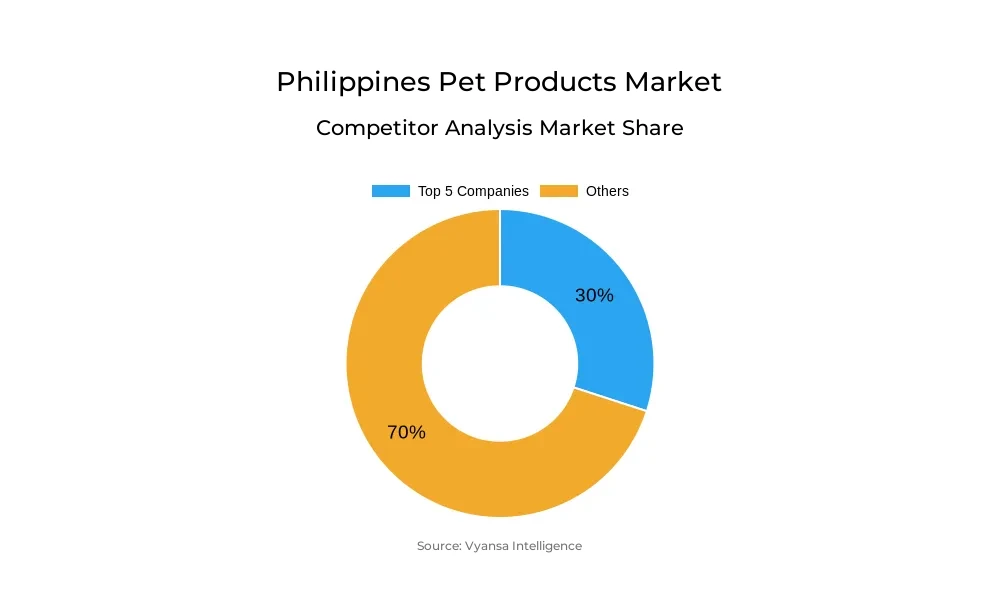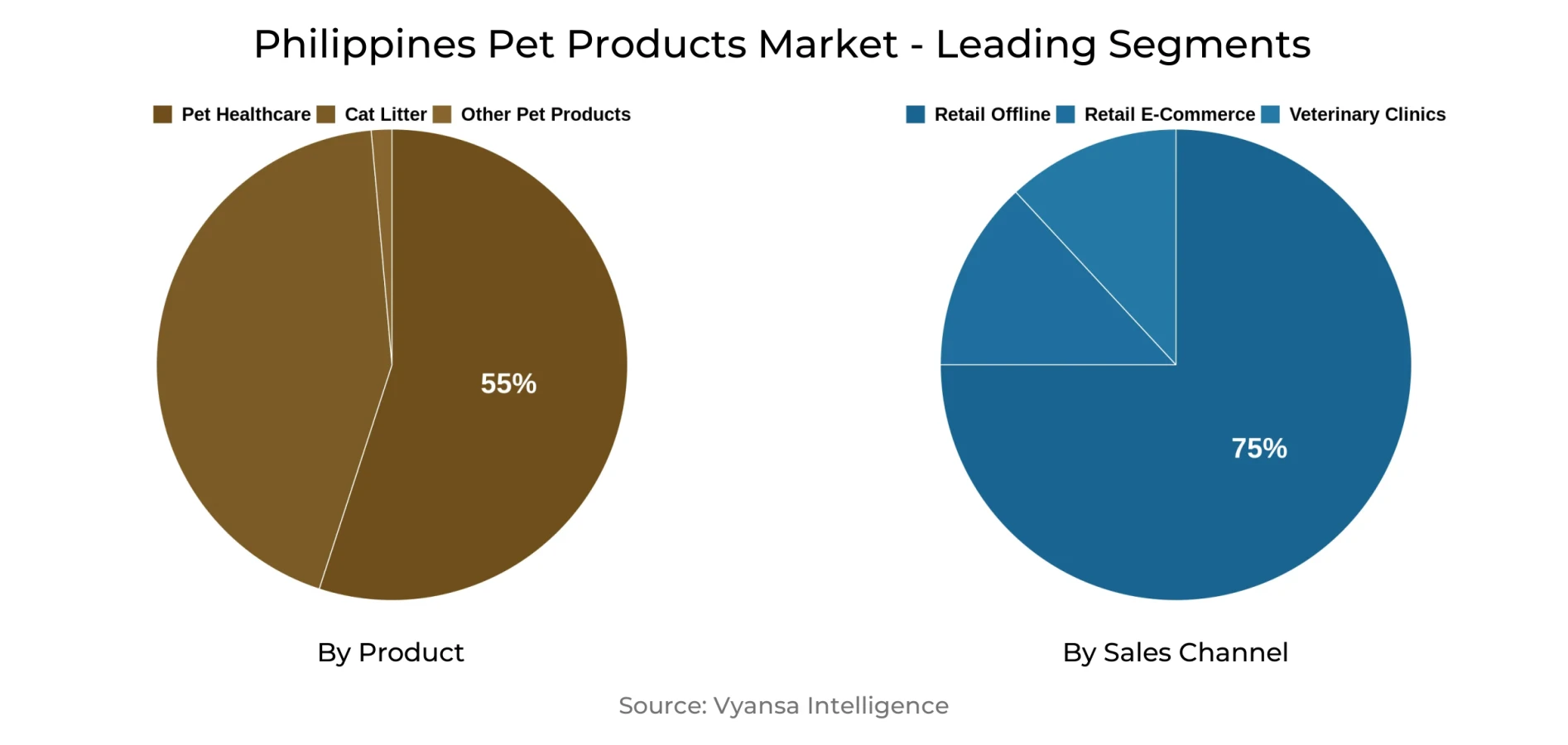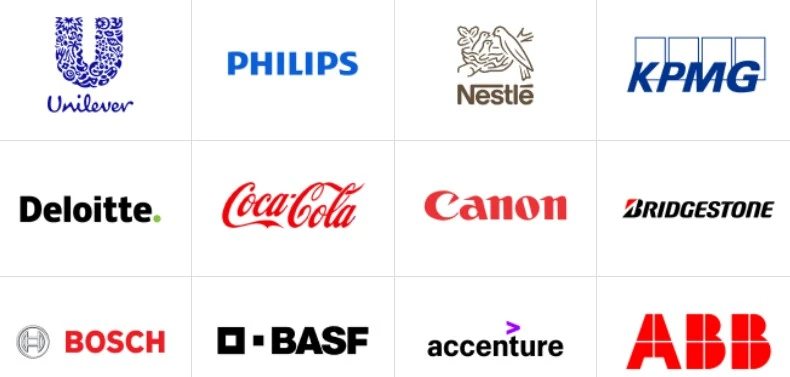Philippines Pet Products Market Report: Trends, Growth and Forecast (2026-2032)
By Product (Cat Litter, Pet Healthcare (Flea/Tick Treatments, Pet Dietary Supplements, Worming Treatments, Others), Other Pet Products (Beauty Products, Accessories, Others)), By Sales Channel (Retail Offline, Retail E-Commerce, Veterinary Clinics)
- FMCG
- Dec 2025
- VI0300
- 110
-




Philippines Pet Products Market Statistics and Insights, 2026
- Market Size Statistics
- Pet Products in the Philippines is estimated at $ 35 Million.
- The market size is expected to grow to $ 45 Million by 2032.
- Market to register a CAGR of around 3.66% during 2026-32.
- Product Shares
- Pet Healthcare grabbed market share of 55%.
- Competition
- More than 20 companies are actively engaged in producing Pet Products in the Philippines.
- Top 5 companies acquired 30% of the market share.
- HerbalMed Asia Corp, AMN Shield Inc, Leomie Jhoy Enterprises, Elanco Philippines Inc, Gilbert Emerson Marketing Corp etc., are few of the top companies.
- Sales Channel
- Retail Offline grabbed 75% of the market.
Philippines Pet Products Market Outlook
Philippines pet products market is valued at approximately $35 million in 2025 and will register a steady growth to reach $45 million by 2032. This is due to growing pet ownership, particularly among urban Millennials and Gen Z, who regard their pets as family and spend more on their health and well-being. Pet humanisation is fueling demand not only for simple healthcare items such as flea and worm treatments but also for supplements, toys, and comfort items that enhance the quality of life for pets.
Over 20 firms are now manufacturing pet products in the Philippines, and of these, the top five firms dominate the market share of around 30%. The competitive market is still scattered across various categories, such as cat litter, where convenience and affordability are the driving factors. As urbanization continues to increase, cat litter sales are likely to grow briskly as more pet owners house cats indoors for reasons of hygiene and security.
Retail offline channels have a stronghold with their share of about 75% of sales, led by supermarkets and pet shops selling routine pet healthcare products and accessories. E-commerce, though, is gaining significance because of its convenience, broader range of products, and availability of premium and niche brands. Social media and online space are playing a growing role in deciding what consumers buy, particularly for health and wellness products.
Looking to the future, manufacturers will have to shift their attention to creating urban-comfort products, like soothing accessories and indoor pets interactive toys. They will also have to authenticate products, especially on digital platforms, to gain End users confidence. Generally, the market forecast is optimistic, underpinned by continued urbanisation, digital uptake, and changing pet owners' lifestyles.

Philippines Pet Products Market Trend
Accelerating urbanization of main cities like Metro Manila, Cebu, and Davao is leading to an increase in pet ownership by Millennials, Gen Z, and young working professionals living in high-rise buildings and tiny abodes. This movement is fueling the need for pet products that are specifically designed for small, indoor settings. Consequently, there has been increasing demand for products like puzzle feeders, interactive toys, and cat towers, which provide mental challenge and serve to minimize behavioural problems in pets kept indoors.
In addition, living indoors subjects pets to greater noise and footfall levels, causing more stress and anxiety. This is driving demand for relaxing pet solutions like stress-relief chewing items and food supplements. Further, the convenience need among time-strapped urban consumers is driving the uptake of intelligent pet technologies like auto feeders and monitoring systems, allowing pets to be cared for more effectively even in the absence of the owner.
Philippines Pet Products Market Opportunity
Social media sites such as TikTok and Facebook will be instrumental in growing the pet product industry in the Philippines. With technologies including in-video product links, flash sales, and live selling, such platforms will facilitate easier connection for sellers with both tech-literate Millennials and Gen Z consumers who are both tech-savvy and pet-crazy. This integrated mix of content and commerce will foster impulse buying and lift brand discovery, resulting in overall sales of pet health care, cat litter, and accessories.
Moreover, social commerce will also alleviate issues of product authenticity, particularly for health products. Sellers can leverage such platforms to feature certified and original products, gaining the trust of consumers who are suspicious of fake goods. Through transparency and direct communication, social media will be an important vehicle for pet product sellers to assuage consumers and expand their share in the market.
| Report Coverage | Details |
|---|---|
| Market Forecast | 2026-32 |
| USD Value 2025 | $ 35 Million |
| USD Value 2032 | $ 45 Million |
| CAGR 2026-2032 | 3.66% |
| Largest Category | Pet Healthcare segment leads with 55% market share |
| Top Trends | Growing Emphasis on Indoor-Friendly and Soothing Pet Solutions |
| Top Opportunities | Increasing Role of Social Media in the Pet Product Market |
| Key Players | HerbalMed Asia Corp, AMN Shield Inc, Leomie Jhoy Enterprises, Elanco Philippines Inc, Gilbert Emerson Marketing Corp, AVLI Biocare Inc, Mikolas Trading Corp, Biochemica Inc, Mars Philippines Inc, Kit Cat International Pte Ltd and Others. |
Philippines Pet Products Market Segmentation Analysis

By Sales Channel
- Retail Offline
- Retail E-Commerce
- Veterinary Clinics
The most market-share dominated segment in the Philippines Pet Products Market 2026-32 sales channel is retail offline, which captures 75% of the market. Under the same channel, supermarkets continue to top the distribution point, selling a simple range of pet health products, cat litter, and best-selling pet accessories. These retailers appeal to a wide clientele by emphasizing the everyday needs of pets and stocking affordable, mass-market items such as pet vitamins, worming drugs, and low-end flea/tick products. One of the main drivers of consumer preference in this category is the convenience of buying pet products along with regular food.
Supermarkets carry typical, non-clumping, clay-type cat litter and working accessories like plain food bowls, leashes, and collars. Specialized items such as grooming kits and strollers are typically offered at pet shops, superstores, or specialty stores, catering to end users in search of more specialized or high-end products. This segmentation showcases the way offline retail channels command the market by catering to the primary and convenient needs of the majority of pet owners.
Top Companies in Philippines Pet Products Market
The top companies operating in the market include HerbalMed Asia Corp, AMN Shield Inc, Leomie Jhoy Enterprises, Elanco Philippines Inc, Gilbert Emerson Marketing Corp, AVLI Biocare Inc, Mikolas Trading Corp, Biochemica Inc, Mars Philippines Inc, Kit Cat International Pte Ltd, etc., are the top players operating in the the Philippines Pet Products Market.
Frequently Asked Questions
Related Report
1. Market Segmentation
1.1. Research Scope
1.2. Research Methodology
1.3. Definitions and Assumptions
2. Executive Summary
3. Philippines Pet Products Market Policies, Regulations, and Standards
4. Philippines Pet Products Market Dynamics
4.1. Growth Factors
4.2. Challenges
4.3. Trends
4.4. Opportunities
5. Philippines Pet Products Market Statistics, 2022-2032F
5.1. Market Size & Growth Outlook
5.1.1.By Revenues in US$ Million
5.2. Market Segmentation & Growth Outlook
5.2.1.By Product
5.2.1.1. Cat Litter- Market Insights and Forecast 2022-2032, USD Million
5.2.1.2. Pet Healthcare- Market Insights and Forecast 2022-2032, USD Million
5.2.1.2.1. Flea/Tick Treatments- Market Insights and Forecast 2022-2032, USD Million
5.2.1.2.2. Pet Dietary Supplements- Market Insights and Forecast 2022-2032, USD Million
5.2.1.2.3. Worming Treatments- Market Insights and Forecast 2022-2032, USD Million
5.2.1.2.4. Others- Market Insights and Forecast 2022-2032, USD Million
5.2.1.3. Other Pet Products- Market Insights and Forecast 2022-2032, USD Million
5.2.1.3.1. Beauty Products- Market Insights and Forecast 2022-2032, USD Million
5.2.1.3.2. Accessories- Market Insights and Forecast 2022-2032, USD Million
5.2.1.3.3. Others- Market Insights and Forecast 2022-2032, USD Million
5.2.2.By Sales Channel
5.2.2.1. Retail Offline- Market Insights and Forecast 2022-2032, USD Million
5.2.2.2. Retail E-Commerce- Market Insights and Forecast 2022-2032, USD Million
5.2.2.3. Veterinary Clinics- Market Insights and Forecast 2022-2032, USD Million
5.2.3.By Competitors
5.2.3.1. Competition Characteristics
5.2.3.2. Market Share & Analysis
6. Philippines Cat Litter Products Market Statistics, 2022-2032F
6.1. Market Size & Growth Outlook
6.1.1.By Revenues in US$ Million
6.2. Market Segmentation & Growth Outlook
6.2.1.By Sales Channel- Market Insights and Forecast 2022-2032, USD Million
7. Philippines Pet Healthcare Market Statistics, 2022-2032F
7.1. Market Size & Growth Outlook
7.1.1.By Revenues in US$ Million
7.2. Market Segmentation & Growth Outlook
7.2.1.By Product- Market Insights and Forecast 2022-2032, USD Million
7.2.2.By Sales Channel- Market Insights and Forecast 2022-2032, USD Million
8. Philippines Other Pet Products Market Statistics, 2022-2032F
8.1. Market Size & Growth Outlook
8.1.1.By Revenues in US$ Million
8.2. Market Segmentation & Growth Outlook
8.2.1.By Product- Market Insights and Forecast 2022-2032, USD Million
8.2.2.By Sales Channel- Market Insights and Forecast 2022-2032, USD Million
9. Competitive Outlook
9.1. Company Profiles
9.1.1.Elanco Philippines Inc
9.1.1.1. Business Description
9.1.1.2. Product Portfolio
9.1.1.3. Collaborations & Alliances
9.1.1.4. Recent Developments
9.1.1.5. Financial Details
9.1.1.6. Others
9.1.2.Gilbert Emerson Marketing Corp
9.1.2.1. Business Description
9.1.2.2. Product Portfolio
9.1.2.3. Collaborations & Alliances
9.1.2.4. Recent Developments
9.1.2.5. Financial Details
9.1.2.6. Others
9.1.3.AVLI Biocare Inc
9.1.3.1. Business Description
9.1.3.2. Product Portfolio
9.1.3.3. Collaborations & Alliances
9.1.3.4. Recent Developments
9.1.3.5. Financial Details
9.1.3.6. Others
9.1.4.Mikolas Trading Corp
9.1.4.1. Business Description
9.1.4.2. Product Portfolio
9.1.4.3. Collaborations & Alliances
9.1.4.4. Recent Developments
9.1.4.5. Financial Details
9.1.4.6. Others
9.1.5.Biochemica Inc
9.1.5.1. Business Description
9.1.5.2. Product Portfolio
9.1.5.3. Collaborations & Alliances
9.1.5.4. Recent Developments
9.1.5.5. Financial Details
9.1.5.6. Others
9.1.6.HerbalMed Asia Corp
9.1.6.1. Business Description
9.1.6.2. Product Portfolio
9.1.6.3. Collaborations & Alliances
9.1.6.4. Recent Developments
9.1.6.5. Financial Details
9.1.6.6. Others
9.1.7.AMN Shield Inc
9.1.7.1. Business Description
9.1.7.2. Product Portfolio
9.1.7.3. Collaborations & Alliances
9.1.7.4. Recent Developments
9.1.7.5. Financial Details
9.1.7.6. Others
9.1.8.Leomie Jhoy Enterprises
9.1.8.1. Business Description
9.1.8.2. Product Portfolio
9.1.8.3. Collaborations & Alliances
9.1.8.4. Recent Developments
9.1.8.5. Financial Details
9.1.8.6. Others
9.1.9.Mars Philippines Inc
9.1.9.1. Business Description
9.1.9.2. Product Portfolio
9.1.9.3. Collaborations & Alliances
9.1.9.4. Recent Developments
9.1.9.5. Financial Details
9.1.9.6. Others
9.1.10. Kit Cat International Pte Ltd
9.1.10.1. Business Description
9.1.10.2. Product Portfolio
9.1.10.3. Collaborations & Alliances
9.1.10.4. Recent Developments
9.1.10.5. Financial Details
9.1.10.6. Others
10. Disclaimer
| Segment | Sub-Segment |
|---|---|
| By Product |
|
| By Sales Channel |
|
Research Methodology
This study followed a structured approach comprising four key phases to assess the size and scope of the electro-oxidation market. The process began with thorough secondary research to collect data on the target market, related markets, and broader industry context. These findings, along with preliminary assumptions and estimates, were then validated through extensive primary research involving industry experts from across the value chain. To calculate the overall market size, both top-down and bottom-up methodologies were employed. Finally, market segmentation and data triangulation techniques were applied to refine and validate segment-level estimations.
Secondary Research
The secondary research phase involved gathering data from a wide range of credible and published sources. This step helped in identifying industry trends, defining market segmentation, and understanding the market landscape and value chain.
Sources consulted during this phase included:
- Company annual reports, investor presentations, and press releases
- Industry white papers and certified publications
- Trade directories and market-recognized databases
- Articles from authoritative authors and reputable journals
- Gold and silver standard websites
Secondary research was critical in mapping out the industry's value chain and monetary flow, identifying key market segments, understanding regional variations, and tracking significant industry developments.
Other key sources:
- Financial disclosures
- Industry associations and trade bodies
- News outlets and business magazines
- Academic journals and research studies
- Paid industry databases
Primary Research
To validate secondary data and gain deeper market insights, primary research was conducted with key stakeholders across both the supply and demand sides of the market.
On the demand side, participants included decision-makers and influencers from end-user industries—such as CIOs, CTOs, and CSOs—who provided first-hand perspectives on market needs, product usage, and future expectations.
On the supply side, interviews were conducted with manufacturers, industry associations, and institutional participants to gather insights into current offerings, product pipelines, and market challenges.
Primary interviews provided critical inputs such as:
- Market size and revenue data
- Product and service breakdowns
- Market forecasts
- Regional and application-specific trends
Stakeholders consulted included:
- Leading OEM and solution providers
- Channel and distribution partners
- End users across various applications
- Independent consultants and industry specialists
Market Size Estimation and Data Triangulation
- Identifying Key Market Participants (Secondary Research)
- Goal: To identify the major players or companies in the target market. This typically involves using publicly available data sources such as industry reports, market research publications, and financial statements of companies.
- Tools: Reports from firms like Gartner, Forrester, Euromonitor, Statista, IBISWorld, and others. Public financial statements, news articles, and press releases from top market players.
- Extracting Earnings of Key Market Participants
- Goal: To estimate the earnings generated from the product or service being analyzed. This step helps in understanding the revenue potential of each market player in a specific geography.
- Methods: Earnings data can be gathered from:
- Publicly available financial reports (for listed companies).
- Interviews and primary data sources from professionals, such as Directors, VPs, SVPs, etc. This is especially useful for understanding more nuanced, internal data that isn't publicly disclosed.
- Annual reports and investor presentations of key players.
- Data Collation and Development of a Relevant Data Model
- Goal: To collate inputs from both primary and secondary sources into a structured, data-driven model for market estimation. This model will incorporate key market KPIs and any independent variables relevant to the market.
- Key KPIs: These could include:
- Market size, growth rate, and demand drivers.
- Industry-specific metrics like market share, average revenue per customer (ARPC), or average deal size.
- External variables, such as economic growth rates, inflation rates, or commodity prices, that could affect the market.
- Data Modeling: Based on this data, the market forecasts are developed for the next 5 years. A combination of trend analysis, scenario modeling, and statistical regression might be used to generate projections.
- Scenario Analysis
- Goal: To test different assumptions and validate how sensitive the market is to changes in key variables (e.g., market demand, regulatory changes, technological disruptions).
- Types of Scenarios:
- Base Case: Based on current assumptions and historical data.
- Best-Case Scenario: Assuming favorable market conditions, regulatory environments, and technological advancements.
- Worst-Case Scenario: Accounting for adverse factors, such as economic downturns, stricter regulations, or unexpected disruptions.
Partnering With Industry Leaders to Drive Growth
Our mission is to deliver intelligence that matters. By combining data, analysis, and industry expertise, we enable organizations to make smarter, faster, and more impactful decisions. Whether it’s a Fortune 500 company or a high-growth startup, businesses trust us to provide clarity in an ever-evolving marketplace.






